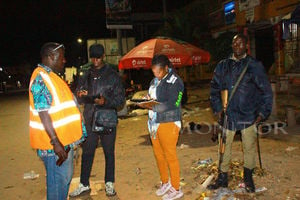Prime
Ntare School: Let the lion roar forever

AUTHOR: Ben Matsiko Kahunga. PHOTO/FILE/COURTESY
What you need to know:
- This and more, you will discover in a captivating, easy-to-read book about the school, authored by its longest serving Ugandan headmaster so far, though he retired in 2003. Written in a thematic style akin to Terry Leahy’s Management in Ten Words, the book is not so much about the life of its author, Stephen Kamuhanda.
Did you know that there is something unique, a mystique, about the air in Mbarara, which renders the place conducive to learning? And did you know that the lion statue that welcomes you into Ntare School campus literally roars?
This and more, you will discover in a captivating, easy-to-read book about the school, authored by its longest serving Ugandan headmaster so far, though he retired in 2003. Written in a thematic style akin to Terry Leahy’s Management in Ten Words, the book is not so much about the life of its author, Stephen Kamuhanda. It extols organisational leadership and what it takes to excel amidst challenges, setbacks and occasional open hostility. (Terry Leahy is the British retired chief executive of Tesco, who grew the company from a humble store to the multinational giant that it is today). The common thread in the two books is that the authors hardly project their individual life achievements while at the helm of both organisations, but rather the evolution and journey of the organisations where they were the team leaders and torchbearers.
The overarching language in Kamuhanda’s book is the first-person plural: ‘…we met, discussed, resolved, worked and stood together…. we succeeded…we together restored Ntare School to its glory’. This permeates the entire book and is manifest in the leadership style of the author as the headmaster of a school to which he was appointed with key result areas clearly defined.
Founded in 1956 by the then colonial government, Ntare School is among the few schools in Uganda that were not founded by missionaries of the three leading faiths in Uganda. And the school hit the road running, with stellar performance in Cambridge exams by its pioneer students.
This is what led the founding headmaster William Crichton to wonder whether there is a uniqueness about the air in Mbarara that favours learning, in his long article about the history of Ntare School, reproduced verbatim in the book. Named Ntare by Rubambansi Charles Godfrey Gasyonga II, Omugabe (King) of Ankole, the school rose to national prominence in its earlier years, but did not escape the effects of Uganda’s political upheavals and socio-economic decline of the seventies and early eighties. ‘Ntare declined because Uganda declined’, the author asserts.
And so, it was that when Kamuhanda was appointed to head the school in 1991, his was a specific assignment to restore the school to its past glory. And this he achieved thanks to a leadership style that combined team leadership with tough love.
Team leadership is evident in the engagement with teachers, school prefects and students in the day-to-day management of the school; while engaging the board of governors, PTA and the old boys’ association (NSOBA) in matters of a policy and strategic nature. While practices such as morning and evening preps are a standard given in all schools today, this was not the case in Ntare at the time Kamuhanda took over leadership.
Through parental talk with occasional tough love to students, iced with benchmark visits by prefects to schools like King’s College Budo (where he had come from), a culture of preps and other structured activities at the school soon evolved. And the school regained its glory as evident in the national examinations performance in the years following Kamuhanda’s take-over.
Given the school’s history and stature in the country and the region, with prominent old boys that include President Yoweri Museveni of Uganda and President Kagame of Rwanda, its leadership and general affairs have not escaped the inherent and emerging interests that characterise Uganda’s socio-political and cultural dynamics. This is evident in the initial resistance to Kamuhanda’s leadership as well as the strike that almost tarnished his career in 2001, only two years to his retirement. He however retired in honour, after 12 years at the helm of Ntare School. The book is a must read for all leaders and citizens.



